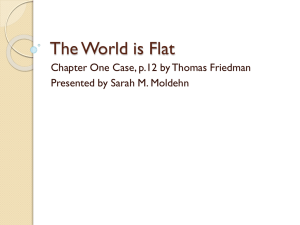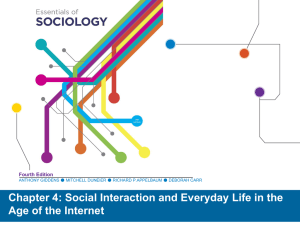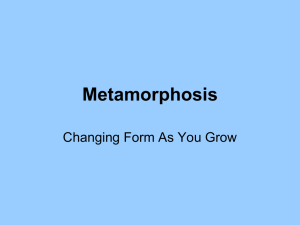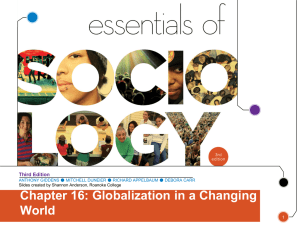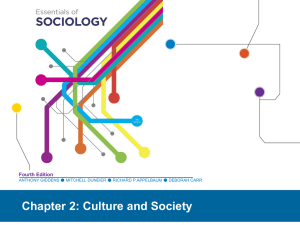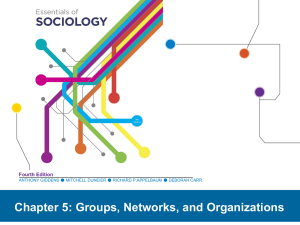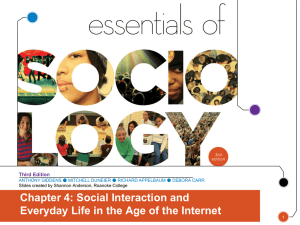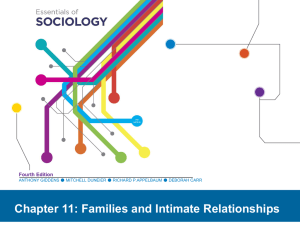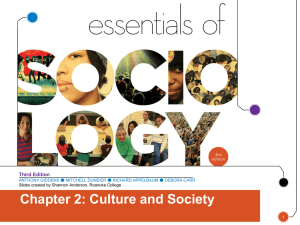Chapter 16
advertisement
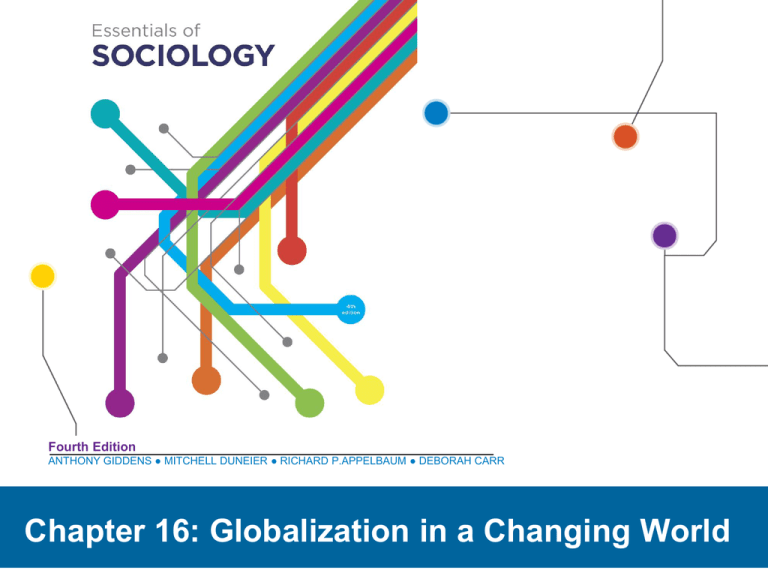
Fourth Edition ANTHONY GIDDENS ● MITCHELL DUNEIER ● RICHARD P.APPELBAUM ● DEBORAH CARR Chapter 16: Globalization in a Changing World © 2013 W. W. Norton Co., Inc. 2 The big issues • Defining globalization • Connecting globalization to modernity and major social change • Examining social movements: what they are and how they are global • Exploring which social forces lead to increased globalization © 2013 W. W. Norton Co., Inc. 3 Globalization and social change • Globalization is the process through which the world is increasingly connected and interdependent. – At level of individuals, groups, organizations, states, and so on – This process is largely associated with economic and political change. • In the modern period, globalization has accelerated rapidly. © 2013 W. W. Norton Co., Inc. 4 Linking globalization and social change • • • • • Responding to environmental factors Emergence of the political state New communication technologies Religious pluralism and the need for tolerance Expansion of industrial capitalism © 2013 W. W. Norton Co., Inc. 5 What follows modern society? • Postindustrial society: Knowledge and service become the primary products. • Postmodernity: A rupture with core understandings of history and belief—no central narratives, only diversity © 2013 W. W. Norton Co., Inc. 6 The “Geek Squad,” a company founded by Robert Stephens in Minneapolis, Minnesota, and later purchased by the Best Buy retail chain, provides consumer computer support and technical repairs. © 2013 W. W. Norton Co., Inc. Social movements and social change • Collective action is a factor in social change. • Many movements today—including the anti-globalization movement—are global in scope. • We now have new social movements, which are less goal-oriented and more identity-oriented. © 2013 W. W. Norton Co., Inc. 8 Approaches to social movements • • • • Economic deprivation Resource mobilization Structural strain Fields of action © 2013 W. W. Norton Co., Inc. 9 Modern technology and social movements • Use of the Internet for organization and fundraising • Speeds up the process with instant information and response • Allows for fast coordination of events like rallies, protests, and so on • Could indicate a shift in power © 2013 W. W. Norton Co., Inc. 10 What makes globalization? • Economic factors – Transnational corporations – Integrated financial markets • Global flow of information and communication – Over 2 billion Internet users worldwide in spring 2011 © 2013 W. W. Norton Co., Inc. 11 What makes globalization? • Political changes – Fall of communist regimes – Rise of IGOs and INGOs – Rising importance of international coalitions (the European Union, United Nations, etc.) © 2013 W. W. Norton Co., Inc. 12 Globalization in everyday life 1. IKEA furniture 2. Wii games 3. H&M fashions 4. L’Oréal shampoos or beauty products 5. Samsung cell phone or PDA 6. Molson beer 7. Birkenstock sandals 8. Diesel jeans 9. Apple iPhone 10. American Express credit card © 2013 W. W. Norton Co., Inc. ______________ ______________ ______________ ______________ ______________ ______________ ______________ ______________ ______________ ______________ 13 Globalization in everyday life 1. IKEA: founded in Sweden, now owned by a Dutch foundation 2. Wii: MNC in Kyoto, Japan 3. H&M: Swedish company 4. L’Oréal: Paris suburb 5. Samsung cell or PDA: Seoul, South Korea 6. Molson beer: Montreal, Canada © 2013 W. W. Norton Co., Inc. 14 Globalization in everyday life 7. Birkenstock sandals: Germany 8. Diesel jeans: Molvena, Italy 9. Apple iPhone: established in California, parts from China 10. American Express: New York City © 2013 W. W. Norton Co., Inc. 15 The globalization debate • There are three main positions: – Skeptics – Hyperglobalizers – Transformationalists © 2013 W. W. Norton Co., Inc. 16 Table 16.2 Conceptualizing Globalization: Three Tendencies © 2013 W. W. Norton Co., Inc. How we feel about globalization • Increasing need to construct our identities • Significant shifts in work and family life • Ubiquity of Western—especially American— popular culture © 2013 W. W. Norton Co., Inc. 18 Risk in a global world • Manufactured risk versus external risk • Potentially devastating consequences – – – – – Urbanization and industrialization Pollution Global warming Nuclear power Bioengineered food © 2013 W. W. Norton Co., Inc. 19 Global inequality • Wealth increasingly concentrated in the developed world – Poorest 40 percent of global population = 5 percent of global income – Richest 10 percent = 54 percent of global income • Global markets have exacerbated this problem: the gap between rich and poor is growing. © 2013 W. W. Norton Co., Inc. 20 The Widening Gap Between Richer and Poor Countries, 1800 to 2008 Note: GDP for South Africa from 1911; 1900 data not available © 2013 W. W. Norton Co., Inc. SOURCE: Gapminder.com 2009 World Bank 2011C. The Widening Gap Between Richer and Poorer Countries, 1800 to 2010 GDP PER CAPITA * 1800 2010 2010 USA $1,343 $47,184 Japan $896 $43,137 Germany $1,643 $40,509 Republic of Korea $740 $20,767 Brazil $509 $10,710 South Africa $759 $7,275 China $992 $4,393 Egypt $748 $2,699 Pakistan $665 $1,007 Dem. Rep. of Congo $394 1980 1950 Low income countries Medium income countries High income countries $199 MEDIAN GDP PER CAPITA * 2010 U.S. $ $40K Note: GDP for South Africa from 1911; 1900 data not available 1900 $20K $0K 1800 1800 1850 1900 1950 2000 SOURCE: Gapminder.com 2009. World Bank 2011C. © 2013 W. W. Norton Co., Inc. Does free trade help? • Many INGOs believe free trade will reduce global inequality. • Critics argue that a global justice movement that pushes for trade organized around protecting rights and resources is needed. © 2013 W. W. Norton Co., Inc. 23 This concludes the Lecture PowerPoint Presentation for Chapter 16: Globalization in a Changing World For more learning resources, please visit our online StudySpace at: http://www.wwnorton.com/college/soc/essentials-of-sociology7/ W. W. Norton & Company Independent and Employee-Owned © 2013 W. W. Norton Co., Inc. Clicker Questions 1. Social change is the transformation over time of a. revolution. b. the institutions and culture of society. c. social movements. d. collective behavior. © 2013 W. W. Norton Co., Inc. 25 Clicker Questions 2. Which of the following is considered a cultural factor in social change? a. political organization b. religion c. environmental conditions d. industrial capitalism © 2013 W. W. Norton Co., Inc. 26 Clicker Questions 3. What factor helps to explain the rise of new social movements over the past few decades? a. Traditional political institutions are increasingly ignoring a whole set of new threats, ranging from environmental crises to genetically modified organisms, because they are unable to cope with the challenges of trying to find solutions to them. b. People today feel less isolated than in the past and are more willing to join movements. c. Because these new movements are so focused on the economics and politics of globalization, people from around the world are drawn to them. d. People today feel more entitled and bold when it comes to challenging the government. © 2013 W. W. Norton Co., Inc. 27 Clicker Questions 4. When it comes to debates on globalization, Joaquin believes that present levels of economic interdependence are not unprecedented and that the growth of regionalization is evidence that the world economy has become less rather than more integrated. To which school of thought does Joaquin belong? a. skeptics b. transformationalists c. hyperglobalizers d. individualists © 2013 W. W. Norton Co., Inc. 28 Clicker Questions 5. Globalization has many consequences. Next to mounting ___________ problems, the expansion of inequalities within and between societies is one of the most serious challenges facing the world at the start of the twenty-first century. a. ecological b. communication c. political d. individual © 2013 W. W. Norton Co., Inc. 29

